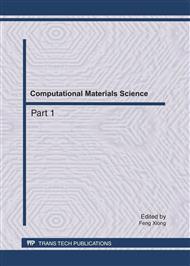[1]
Amparo Navasa, Miguel A. Pérez-Toledano, Juan M. Murillo: An ADL dealing with aspects at software architecture stage. Information and Software Technology, Vol. 51, pp.306-324, (2009).
DOI: 10.1016/j.infsof.2008.03.009
Google Scholar
[2]
Monica Pinto and Lidia Fuentes: AO-ADL: An ADL for Describing Aspect-Oriented Architectures. Springer-Verlag Berlin Heidelberg, pp.94-114, (2007).
DOI: 10.1007/978-3-540-76811-1_6
Google Scholar
[3]
Subramanian N, Chung L: Process-Oriented Metrics for Software Architecture Adaptability. In Proceedings of the 5th IEEE International Symposium on Requirements Engineering, pp.301-311, (2001).
DOI: 10.1109/isre.2001.948599
Google Scholar
[4]
Alex C Meng: On Evaluating Self-Adaptive Software. Lecture Notes in Computer Science, Vol. 1936, pp.65-74, (2001).
Google Scholar
[5]
Xia Liu, Qing Wang: Study on Application of a Quantitative Evaluation Approach for Software architecture adaptability. Proceeding of the 5th International Conference on Quality Software, pp.265-272, (2005).
DOI: 10.1109/qsic.2005.59
Google Scholar
[6]
Tarvainen P.: Adaptability Evaluation of Software Architectures: A Case Study. Proceedings of the 31st Annual International Computer Software and Applications Conference. IEEE Computer Society, , pp.579-586, (2007).
DOI: 10.1109/compsac.2007.240
Google Scholar
[7]
Jing Wen, Shi Ying, Linlin Zhang, Youcong Ni: AC2-ADL: Architectural Description of Aspect-Oriented System. International Journal of Software Engineering and Its Applications, Vol. 3 (1), pp.1-10, (2009).
DOI: 10.1109/asea.2008.11
Google Scholar
[8]
Wen Jing, Ying Shi, Ni YouCong, Zhanglinlin: Architectural Design of the Online Auction System with AOSAD. Proceedings. of IEEE International Conference on e-Business Engineering (ICEBE 2008). Xi'an, China, pp.5-12, (2008).
DOI: 10.1109/icebe.2008.41
Google Scholar
[9]
Youcong Ni, Shi Ying, Jing Wen, Linlin Zhang, Peng Ye: Study on Weaving Process at Software Architectural level. Proceedings of 2008 IEEE Asia-Pacific Services Computing Conference (APSCC 2008). Yilan, Taiwan, pp.9-12, (2008).
DOI: 10.1109/apscc.2008.69
Google Scholar
[10]
P. Oreizy, M. M. Gorlick et al.: An Architecture-based Approach to Self-adaptive Software, IEEE Intell. Syst. Appl, Vol. (14)3, pp.54-62, (1999).
DOI: 10.1109/5254.769885
Google Scholar
[11]
M. Matinlassi, E. Niemelä: The impact of maintainability on component-based software systems. Proceedings of the 29th EUROMICRO Conference (EUROMICRO'03), New Waves in System Architecture, pp.25-32, (2003).
Google Scholar
[12]
G. Costagliola, F. Ferrucci, G. Tortora and G. Vitiello: Class Point: An Approach for the Size Estimation of Object-Oriented Systems. IEEE Transactions on Software Engineering, Vol. 31, pp.52-74, (2005).
DOI: 10.1109/tse.2005.5
Google Scholar


